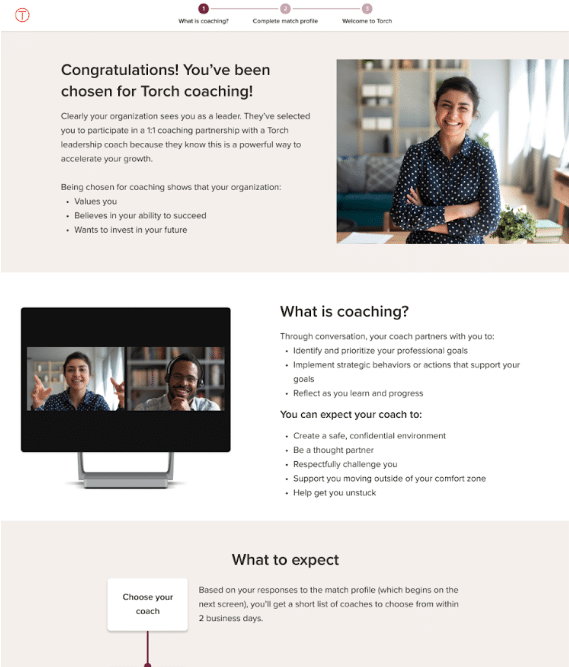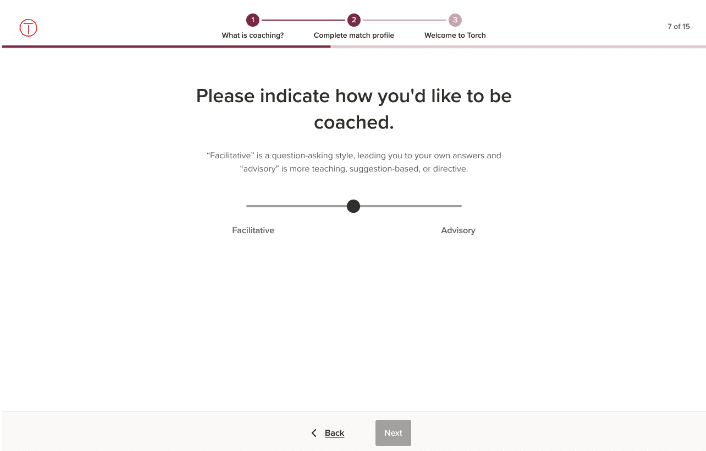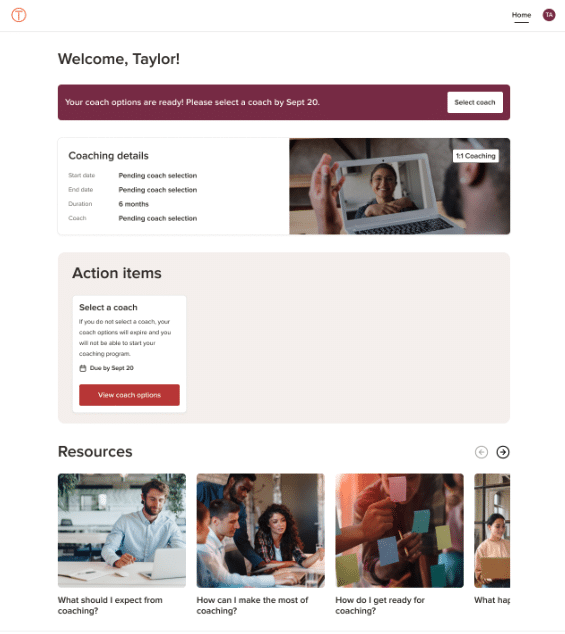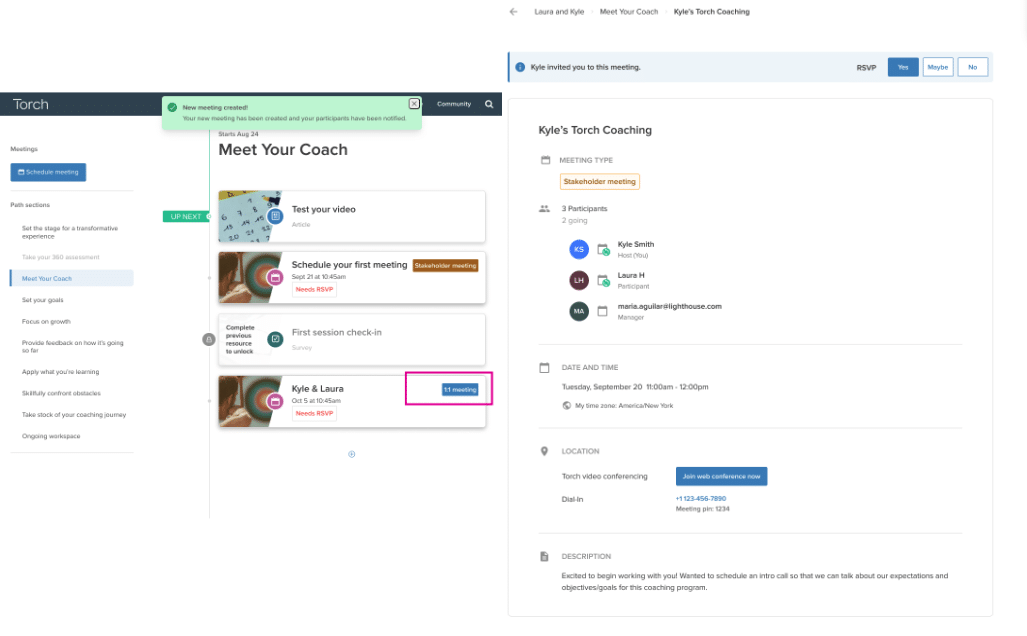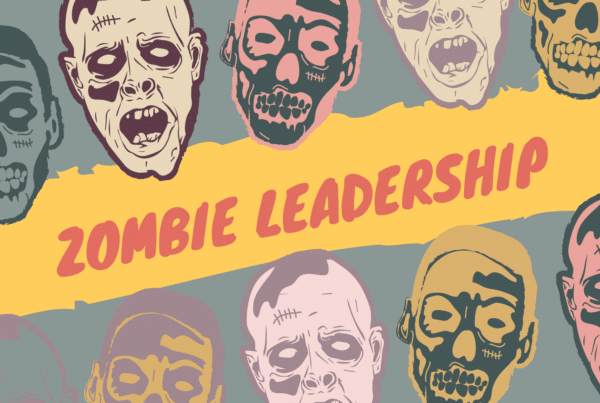You’ve probably heard the saying, “the first impression is the last impression.” Nowhere is that more true than in software. First impressions are enduring and difficult to change once they’re formed. When it comes to coaching, the onboarding experience serves as a participant’s first impression of the program. In addition, research shows that reducing friction early on helps people build the habit of engaging, which leads to more growth and learning.
At Torch, we’re investing in creating the best onboarding experience possible. We wanted to remove any challenges or obstacles participants might face during their onboarding experience that could decrease their momentum or engagement.
The result? A flow that features a streamlined onboarding process, engaging homepage, and built-in tools that enable alignment between coaches, participants, and their managers. By building momentum and a sense of progress early on, Torch fosters an environment conducive to behavior change. Let’s take a quick peek at the three primary components that make up Torch’s onboarding experience:
1. Coach matching
Before participants start thinking about changing their behavior, they need to first understand what coaching is and why they’re doing it. Torch’s onboarding experience begins by giving participants an overview of their coaching engagement and answers these initial questions. This ensures that participants understand what the coaching process will look like and sets initial expectations.
Next, participants take a short matching survey that asks them about their preferences and experiences. For participants to experience meaningful behavior change, they need a coach with whom they can quickly build rapport and trust. The matching profile survey is designed to capture key information around a participant’s experiences, preferences, and background, so that they can be matched with the right coach.
2. A homepage that streamlines onboarding for participants
The homepage is the first place participants go when they log in to their Torch platform. Because onboarding is such a crucial point in an individuals’ coaching journey, we embed the onboarding dashboard right into the homepage. This way, participants are reminded of key action items every time they log in to Torch. Torch’s homepage is streamlined with only the most relevant content to reduce distractions and unnecessary information. It consists of three key sections:
- Important coaching information: participants can find answers to basic questions they might have, such as: “How long will my coaching engagement last?” or “When does my coaching engagement start/end?”, so they don’t have to dig through multiple pages or tabs.
- Key action items: participants can find all the next steps they need to take to complete their onboarding, as well as direct links to complete these items, right from their homepage. This way, participants aren’t left with any ambiguity or confusion around how to complete their tasks. There are also engaging CTAs and banners across the page that encourage participants to complete their tasks.
- Relevant resources: participants can find resources curated by our behavioral science team that answer key questions they may have about coaching, such as: “What should I expect from coaching?” or “How can I make the most of coaching?”
By building onboarding into Torch’s homepage, we’re able to get participants started with coaching and on the path to sustainable behavior change quickly and efficiently.
3. Built-in tools that enable coaching alignment
For participants to successfully change their behavior in the context of coaching, they need to: 1) know what behavior they need to change, and 2) be held accountable for their desired change. While coaches are experts at guiding participants through the behavior change process, they face certain limitations as external figures to the organization. First, coaches’ context around organizational and team goals and challenges is limited to what participants tell them. Second, coaches can only hold participants accountable for their behavior change during coaching sessions, rather than on a day-to-day basis.
To solve these limitations, Torch created Manager Alignment Meetings. Manager Alignment Meetings are optional meetings that allow participants to invite their manager to join a session with their coach at the beginning and end of a coaching engagement. At the beginning of an engagement, a coach, participant, and their manager can meet to align on team challenges and organizational objectives. Participants can also gain insight from their manager around areas of growth the participant could improve upon during the coaching engagement. At the end of an engagement, Manager Alignment Meetings enable managers to provide feedback on areas of behavior change they’ve seen in the participant, as well as commit to future development for the individual. Most importantly, Manager Alignment Meetings allow managers to support the participant through their coaching journey and hold them accountable to their goals on a regular basis.
Behavior change is only possible if participants are engaged and invested in their coaching journey. By optimizing each piece of the onboarding experience, Torch is able to help participants build momentum and increase engagement early on, setting them up for success down the line. Learn more about how Torch’s approach to behavior change can support your organization’s needs by scheduling a personalized walk-through of Torch today.
